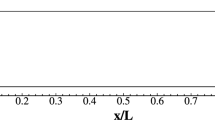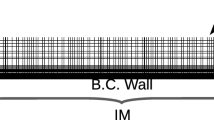Abstract
Recently, computational fluid dynamics (CFD) approaches have been effectively used by researchers to calculate the resistance characteristics of ships that have rough outer surfaces. These approaches are mainly based on modifying wall functions using experimentally pre-determined roughness functions. Although several recent studies have shown that CFD can be an effective tool to calculate resistance components of ships for different roughness conditions, most of these studies were performed using the same ship geometry (KRISO Container Ship). Thus, the effect of ship geometry on the resistance characteristics of rough hull surfaces is worth investigating. In this study, viscous resistance components of four different ships are calculated for different roughness conditions. First, flat plate simulations are performed using a previous experimental study for comparison purposes. Then, the viscous resistance components of three-dimensional hulls are calculated. All simulations are performed using two different turbulence models to investigate the effect of the turbulence model on the results. An examination of the distributions of the local skin friction coefficients of the DTMB 5415 and Series 60 showed that the plumpness of the bow form has a significant effect on the increase in frictional resistance with increasing roughness. Another significant finding of the study is that viscous pressure resistance is directly affected by the surface roughness. For all geometries, viscous pressure resistances showed a significant increase for highly rough surfaces.
Similar content being viewed by others
Abbreviations
- \({{\bar u}_i}\) :
-
Averaged Cartesian velocity components
- ρ :
-
Fluid density
- \(\rho \overline {u_i^\prime u_j^\prime } \) :
-
Reynolds stresses
- \({\bar p}\) :
-
Mean pressure
- \({{\bar \tau }_{ij}}\) :
-
Averaged stress tensor components
- μ :
-
Dynamic viscosity
- SST:
-
Shear stress transport
- RSM:
-
Reynolds stress model
- U + :
-
Normalized mean velocity
- κ :
-
Von Karman constant
- y + :
-
Non-dimensional normal distance from the wall
- ΔU + :
-
Roughness function
- B :
-
Smooth wall log-law intercept
- k + :
-
Roughness Reynolds number
- k s :
-
Characteristic roughness height
- u τ :
-
Friction velocity
- v :
-
Kinematic viscosity
- Rt:
-
Mean height between the highest peak and deepest valley
- Ra:
-
Mean deviation of the surface
- Rq:
-
Root-mean-square deviation of the surface
- Sk:
-
Skewness
- Ku:
-
Kurtosis
- Es:
-
Effective slope
- Sd1, Sd2, Sd3 :
-
Mean spacing between extremes
- Sd4 :
-
Mean spacing between zero crossings
- U ∞ :
-
Free stream velocity
- δ :
-
Boundary layer thickness
- C B :
-
Block coefficient
- R T :
-
Total resistance
- R F :
-
Frictional resistance
- C F :
-
Coefficient of frictional resistance
- C VP :
-
Coefficient of viscous pressure resistance
- V :
-
Ship service speed
- L :
-
Ship length
- Re :
-
Reynolds number
- GCI:
-
Grid convergence index
- N :
-
Number of cells of the meshes
- \(e_a^{21}\) :
-
Approximate relative error of fine mesh with respect to medium mesh
- p a :
-
Apparent order of the magnitude
- RD:
-
Relative difference
- c F :
-
Local skin friction coefficients
- τ wall :
-
Wall sheer stress
- c p :
-
Dynamic pressure coefficient
- p — p ∞ :
-
Dynamic pressure
References
Atlar M, Unal B, Unal UO, Politis G, Martinelli E, Galli G, Davies C, Williams D (2012) An experimental investigation of the frictional drag characteristics of nanostructured and fluorinated fouling-release coatings using an axisymmetric body. Biofouling 29(1): 39–52. https://doi.org/10.1080/08927014.2012.745856
Atlar M, Yeginbayeva IA, Turkmen S, Demirel YK, Carchen A, Marino A, Williams D (2018) A rational approach to predicting the effect of fouling control systems on “in-service” ship performance. GMO Journal of Ship and Marine Technology 213: 5–36
Candries M, Atlar M, Anderson CD (2001) Foul release systems and drag. Consolidation of technical advances in the protective and marine coatings industry. Proceedings of the PCE 2001 Conference, 273–286
CD-ADAPCO (2011) User guide STAR-CCM+. Version 6.06.011
Cebeci T, Bradshaw P (1977) Momentum transfer in boundary layers. Hemisphere Publishing, McGraw-Hill, 176–180
Celik IB, Ghia U, Roache PJ, Freitas CJ, Coleman H, Raad PE (2008) Procedure for estimation and reporting of uncertainty due to discretization in CFD applications. J. Fluids Eng. Trans. ASME 130: 078001–1–4. https://doi.org/10.1115/E2960953
Clauser FH (1954) Turbulent boundary layer in adverse pressure gradients. Journal of the Aeronautical Sciences 21: 91–108. https://doi.org/10.2514/8.2938
Colebrook CF (1939) Turbulent flow in pipes, with particular reference to the transition region between the smooth and rough pipe laws. J. Inst. Civil Eng. 11:133–156. https://doi.org/10.1680/ijoti.1939.13150
Demirel YK (2018) New horizons in marine coatings. GMO Journal of Ship and Marine Technology 213: 37–53
Demirel YK, Khorasanchi M, Turan O, Incecik A, Schultz M (2014) A CFD model for the frictional resistance prediction of antifouling coatings. Ocean Engineering 89:21–31. https://doi.org/10.1016/j.oceaneng.2014.07.017
Demirel YK, Turan O, Incecik A (2017) Predicting the effect of biofouling on ship resistance using CFD. Appl. Ocean Res 62: 100–118. https://doi.org/10.1016/j.apor.2016.12.003
Froude W (1872) Experiments on the surface-friction experienced by a plane moving through water. British Association for the Advancement of Science. The Collected Papers of William Froude, Institution of Naval Architects, 138–146
Froude W (1874) Report to the lords commissioners of the admiralty on experiments for the determination of the frictional resistance of water on a surface, under various conditions, performed at Chelston cross, under the authority of their lordships. 44th Report by the British Association for the Advancement of Science
Grigson CWB (1992) Drag losses of new ships caused by hull finish. J. Ship Res. 36:182–196
Haase M, Zurcher K, Davidson G, Binns JR, Thomas G, Bose N (2016) Novel CFD-based full-scale resistance prediction for large medium-speed catamarans. Ocean Engineering 111(1): 198–208. https://doi.org/10.1016/j.oceaneng.2015.10.018
Hama FR (1954) Boundary layer characteristics for smooth and rough surfaces. Transactions of the Society of Naval Architects and Marine Engineers 62:333–358
Haslbeck EG, Bohlander G (1992) Microbial biofilm effects on drag—lab and field. Proceedings of the SNAME Ship Production Symposium, Paper No. 3A-1
IMO (2009) Report of the marine environment protection committee in its fifty-ninth session. International Maritime Organisation, MEPC 59/24
ITTC (2011) Recommended procedures and guidelines, practical guidelines for ship CFD application. 7.5-03 02-03
Karabulut UC, Özdemir YH, Barlas B (2020) Numerical study on the hydrodynamic performance of antifouling paints. J. Marine. Sci. Appl. 19: 41–52. DOI https://doi.org/10.1007/s11804-020-00130-w
Khor YS, Xiao Q (2011) CFD simulations of the effects of fouling and antifouling. Ocean Engineering 38: 1065–1079 https://doi.org/10.1016/j.oceaneng.2011.03.004
Lackenby H (1962) Resistance of ships with special reference to skin friction and hull surface condition: The 34th Thomas Lowe Grey Lecture, Proceedings of the Institute of Mechanical Engineers 176: 981–1014
Longva T, Eide MS, Skjong R (2010) Determining a required energy efficiency design index level for new ships based on a cost-effectiveness criterion. Maritime Policy & Management 37(2): 129–143. https://doi.org/10.1080/03088830903533759
McEntee W (1915) Variation of frictional resistance of ships with condition of wetted surface. Trans Soc Nav Arch Mar Eng. 24: 37–42. https://doi.org/10.1111/j.1559-3584.1916.tb00632.x
Mikkelsen H, Walther JH (2020) Effect of roughness in full-scale validation of a CFD model of self-propelled ships: Applied Ocean Research 99: 1–14. https://doi.org/10.1016/j.apor.2020.102162
Molland AF, Turnock SR, Hudson DA (2011) Ship resistance and propulsion: practical estimation of ship propulsive power. Cambridge University Press, New York
Nikuradse J (1933) Laws of flow in rough pipes. NACA Technical Memorandum, 1292
Patankar SV, Spalding DB (1972) A calculation procedure for heat, mass and momentum transfer in three-dimensional parabolic flows. Int J Heat Mass Transf 15: 1787–1806. https://doi.org/10.1016/0017-9310(72)90054-3
Patel V (1998) Perspective: Flow at high reynolds number and over rough surfaces—achilles heel of CFD. Journal of Fluids Engineering 120(3): 434–444. https://doi.org/10.1115/1.2820682
Rushd S, Ashraful I, Sanders RS (2018) CFD Methodology to determine the hydrodynamic roughness of a surface with application to viscous oil coatings. J. Hydraul. Eng. 144(2): 04017067. https://doi.org/10.1061/(ASCE)HY.1943-7900.0001369
Schultz MP (2002) The relationship between frictional resistance and roughness for surfaces smoothed by sanding. ASME J. Fluids Eng. 124: 492–499. https://doi.org/10.1115/1.1459073
Schultz MP (2004) Frictional resistance of antifouling coating systems. ASME J. Fluids Eng. 126: 1039–1047. https://doi.org/10.1115/1.1845552
Schultz MP, Walker JM, Steppe CN, Flack KA (2015) Impact of diatomaceous biofilms on the frictional drag of fouling-release coatings. Biofouling 31(9–10): 759–773. DOI: https://doi.org/10.1080/08927014.2015.1108407
Unal OU, Unal B, Atlar M (2012) Turbulent boundary layer measurements over flat surfaces coated by nanostructured marine antifoulings. Experiments in Fluids 52: 1431–1448
Unal UO (2015) Correlation of frictional drag and roughness length scale for transitionally and fully rough turbulent boundary layers. Ocean Engineering 107(2015): 283–298
UNCTAD (2017) Review of maritime transport. United Nations Conference on Trade and Development
Usta O, Korkut E (2013) A study for the effect of surface roughness on resistance characteristics of flat plates. Marine Coatings Conference, London. DOI: https://doi.org/10.3940/rina.coat.2013.03
Wilcox DC (1994) Turbulence modelling for CFD. İkinci Basım, DCW Industries, Colifornia
Author information
Authors and Affiliations
Corresponding author
Additional information
Article Highlights
• Effect of surface roughness on viscos resistance components of several ships is investigated via computational fluid dynamics (CFD).
• Surface conditions of ships were successfully represented by modified wall function approach.
• A verification study was carried using previous experimental results.
• Further CFD simulations were performed using different ship models.
Rights and permissions
About this article
Cite this article
Karabulut, U.C., Özdemir, Y.H. & Barlas, B. Numerical Investigation of the Effect of Surface Roughness on the Viscous Resistance Components of Surface Ships. J. Marine. Sci. Appl. 21, 71–82 (2022). https://doi.org/10.1007/s11804-022-00290-x
Received:
Accepted:
Published:
Issue Date:
DOI: https://doi.org/10.1007/s11804-022-00290-x




